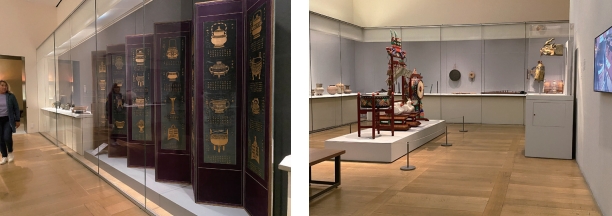August 6, 2022 - October 15, 2023
Metropolitan Museum of Art
1000 Fifth Avenue, New York NY 10028
This exhibition drew a large population, most of whom never heard of the ancestral worship ceremonies in the Confucian tradition. Eleanor Soo-ah Hyun, Associate Curator of Korean Art at the Metropolitan Museum of Art emphasized persistence of performing ancestral rites (jesa) in the post-modern era as of 2023. Visitors are invited to watch a video documentary of The Royal Ancestral Ritual in the Jongmyo Shrine and its Music (宗廟祭禮樂). Most visitors start from the video, move to the musical instruments, and then to ritual objects.
The core of the exhibition is composed of the various types of ritual vessels and accessories called
Jegi from the Three Kingdoms Period to the Joseon dynasty and to the contemporary period. The wall text explains that the vessels come in various shapes, sizes, and materials but they were fit to the purpose of “elevation” with a high foot or a pedestal. The first part of the exhibition starts with bronze-era objects like a red jar in burnished red earthenware of the fourth century CE followed by gold earrings and footed vessels from the Three Kingdoms period. Most of them are familiar objects from the Metropolitan Museum’s permanent collection. Cups in the chariot wheel shape, bird shape, and horn shape are displayed with pedestals or stands.
1
During the Joseon dynasty, the court ancestral rites became the most significant ritual of courtiers’ political life. Thus, ritual music and its instruments were highlighted in the second half of the exhibition. A large section is devoted to O family’s epitaph tablets (
myoji) dated to 1753. A set of thirty-four tablets made of porcelain with underglaze cobalt blue looks imposing. Each tablet has 5 or 6 lines of calligraphy recording the life and achievement of O Myung-hang (1673-1728).
2
An exhibition view of Jegi: Korean Ritual Objects at the Metropolitan Museum of Art. Photo: Kyunghee Pyun, 2023.

The musical instrument section had objects from different periods such as a f lute in Goryeo celadon of the thirteenth century, geomungo of the nineteenth century, and haegeum of 1980.
3 A set of haegeum, sogeum, janggo was a gift of Daewoo Group in 1981. Korean Cultural Service gave Teukgyeong created in 1981 to the Metropolitan Museum in 1982.
4 This work on a large stand is an attraction as visitors spent much time circling it. This was placed along with a video monitor playing the video documentary of the ritual music of the Jongmyo shrine. Due to these, many sat down on the bench and took time to understand the meaning of music in Neo-Confucian rituals.
The exhibition ends with contemporary ceramics by Kim Yik-yung and Lee Kang-hyo as well as a large, embroidered screen of ten panels, each illustrating archaic Chinese bronzes and accompanying texts in the
Jin shi suo of 1893 (Qing dynasty) that circulated throughout Asia.
5 Curator Hyun included two editions in the museum’s collection. Against the indigo silk background, Chinese bronze vessels are embroidered in gold and yellow silk. The entire panels are mounted on purple silk backing. Many of them depicted on the screen are brought to the Korean art gallery and displayed nearby. Or visitors walk to the connected gallery of Chinese art to see larger vessels. It was interesting to learn about the production of this silk screen. The text explains that this could have produced in court workshops, “many of which were situated in Anju, Pyeong’an Province, in present-day North Korea.”
Overall, the exhibition was a successful plan to utilize both familiar and new works of art in the collection of the Metropolitan Museum of Art. For the past two decades, museums try to incorporate the trend of “performing objects” or “theatricality” in the art history scholarship with their exhibition programs.
6 Korean porcelain and metalwork were presented in the ritual context of performativity. While Buddhist rituals have been introduced in Chinese or Japanese art galleries, Neo-Confucianism and its emphasis on harmonious ritual were rather refreshing to both scholars and lay visitors. Using multiple sensory exposure in exhibition design is getting more and more popular. This was a sensitive and engaging presentation of ritual objects from Korean art.






